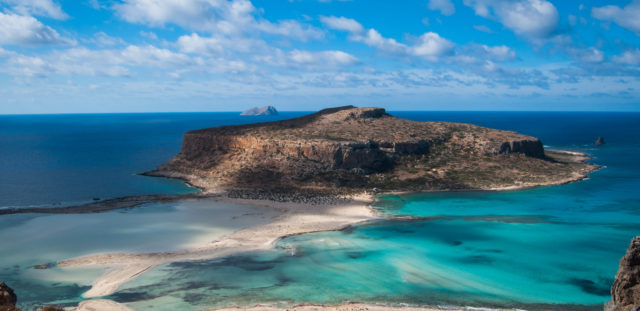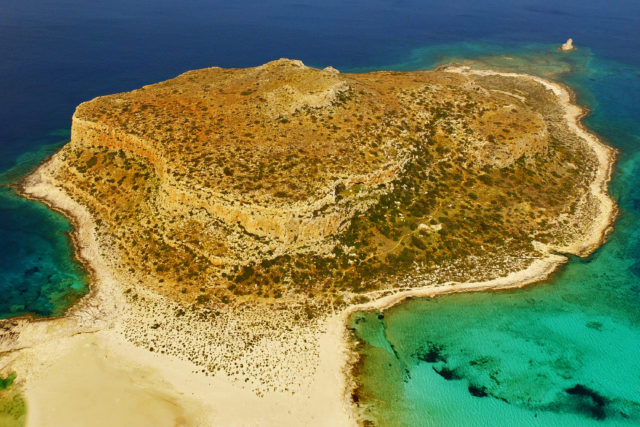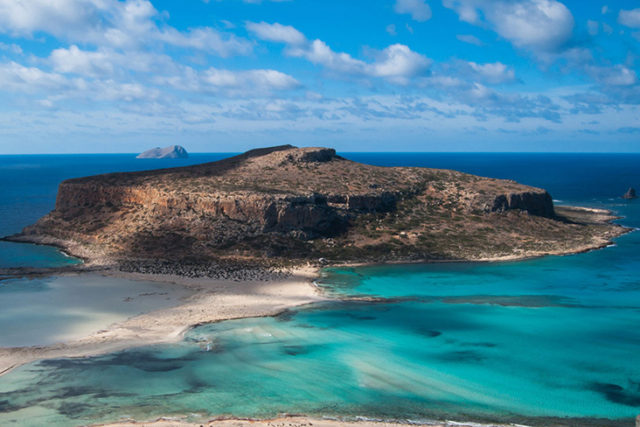Balos Lagoon
AN EXOTIC
PARADISE
Balos lagoon is a heaven on earth of turquoise waters, pink-tinged white sands and wild, exotic beauty. Located at 17 km northwest of Kissamos, between the Gramvousa Cape and small rocky peninsula of Tigani, which connects with the rest of Crete via a thin strip of land, thus forming the famous Balos lagoon. Its southwest side is open to sea and forms a natural harbour, protected by winds due to the islet of Imeri Gramvousa across from it. On its open side the shore is deeper and rockier at places; a favourite for spearfishermen and scuba divers. The other side of the lagoon is closed to the sea and forms a generally quite shallow lagoon, except for some deeper places on its south side.
Accessing Balos can be done three-way: via boat, road or hiking. There are daily morning boats sailing off Kissamos that involve a stop at Imeri Gramvousa with its shipwreck and old Venetian fort. By car via a 10 km dirt road that starts at the village of Kalyviani, runs along the Gramvousa Peninsula and ends up at a large parking spot. The Balos lagoon and Imeri Gramvousa panoramic views at that spot are stunning and considered a once-in-a-lifetime worth the visit. From there, climbing down to the beach is done via a dirt path (with steps at places), accessible only on foot, which is why indulging in it requires a level of preparation and proper shoes.
Climbing back up is somewhat exhausting, especially during midday, so wearing a hat is a must. Nevertheless, the most adventurous and exciting way to reach Balos is the three-hour hike from Kalyviani, amidst the wild setting of Gramvousa Peninsula, a hike that commands appropriate gear and supplies. It is not just the beauty of nature in Balos that makes it so unique but rather the fact it is an aquatic habitat of utmost ecologic significance for a multitude of plants and birds. Specifically, ca. 400 species of plants have been acknowledged, 25 out of which are endemic (namely, grow in a specific geographical location) to Crete and 3 are steno-endemic (grow exclusively in a mountainous or seaside location).
The area of Balos is a permanent resort for many birds, such as lesser kestrels, shags and cormorants, as well as a temporary one for migratory birds. Additionally, the Mediterranean monk seal (Monachus monachus) uses the area as a nesting place while the loggerhead sea turtle (Caretta caretta) frequents the cape shores to feed and lay its eggs. All the above made Balos a solid addition to the ‘Natura 2000’ protection network.
Balos is certainly one of the most advertised and photographed destinations in the world and the favourite subject of all tourist guides. A prospective visitor can find a great deal of information and even more photographic material, but one thing is certain. You will forget all of the above when from the top of the mountain, after the drive and the walk necessary to get there, you face the entrancing view to Balos which emerges majestic. Kissamos awaits to extend its hospitality, to offer you treats and enchant you with places like the Balos Lagoon with the white-pink sand and the strong aquamarine and turquoise waters.
The Gramvousa Peninsula – Balos Lagoon region is included in the Natura 2000 network with the codes GR 4340001 & GR 4340017.
In Balos there are 2 snack-bars that provide the visitor with packaged food and bottled water. Visitors should come with due sensitivity and respect and observe the regulations that apply to the area.
Ways to get to the Balos Lagoon:
By car or motorbike from Kissamos and Kaliviani village on a 10Km road that ends in the parking area. From there you will need to walk about 1Km on the path that leads to the beach.
By boat or private craft.
Advice:
Prefer to visit Balos in April, May, June, September and October.
Make an early start from your hotel to avoid traffic and also to enjoy Balos with as few visitors around as possible.
Take many photographs, the beauty is unsurpassed, and you will need them when you take a trip down memory lane.
Respect the environment. After all, one day it will pay us back.
It is prohibited:
To stay overnight and to remain in the area of the dune ecosystems
To smoke and throw cigarettes at the beach.
To light up a fire.
To throw rubbish unless in the rubbish bins.
To contaminate the water and the wider area in general.
To destroy any kind of natural vegetation.
To hunt.
To install bee hives and bee colonies without a permit from the Forest Authority.
To place signs for advertising purposes.
To climb.
To camp.
To park a car.
DISCOVER ALSO
Elafonisi beach
It takes a few seconds for the visitor arriving at Elafonisi to grasp the majestic, natural masterpiece that is laid out before them. A small peninsula split at its tip by the sea’s waters, resembling a separate island. The setting is tropical and enchanting, triggering an instant sense of marvel. Thin, white and pink tinted sands, cedars, jade crystal-clear waters, a natural lagoon at its north side, the open sea at its south, all underlined by the endless horizon. The beach prompts to an exotic paradise similar to the Caribbean, though perhaps of more beauty because of its iridescent shore; scores of minuscule crustaceans, called Foraminifera shed their shells on the beach, as they die, which are crushed to smithereens…
Falassarna beach
Falasarna beach is located on the Gramvousa Peninsula, 15 km west of Kissamos. This is one of Greece’s most renowned beaches, listed in the top ten of dreamy European shores and has been awarded in the past as Crete’s finest beach. With a vast, ca. 3 km, coastline that essentially consists of five consecutive beaches divided by rocks or sand dunes, with two of them attracting the largest crowds. The most popular is Pachia Ammos, spanning 1 km in length and of ample width; that is why it never looks crowded no matter how many its visitors. Its waters reflect a transparent turquoise tint, thanks to its thin, light-coloured sand and is fully organised hosting restaurants, cafés and bars, water…





